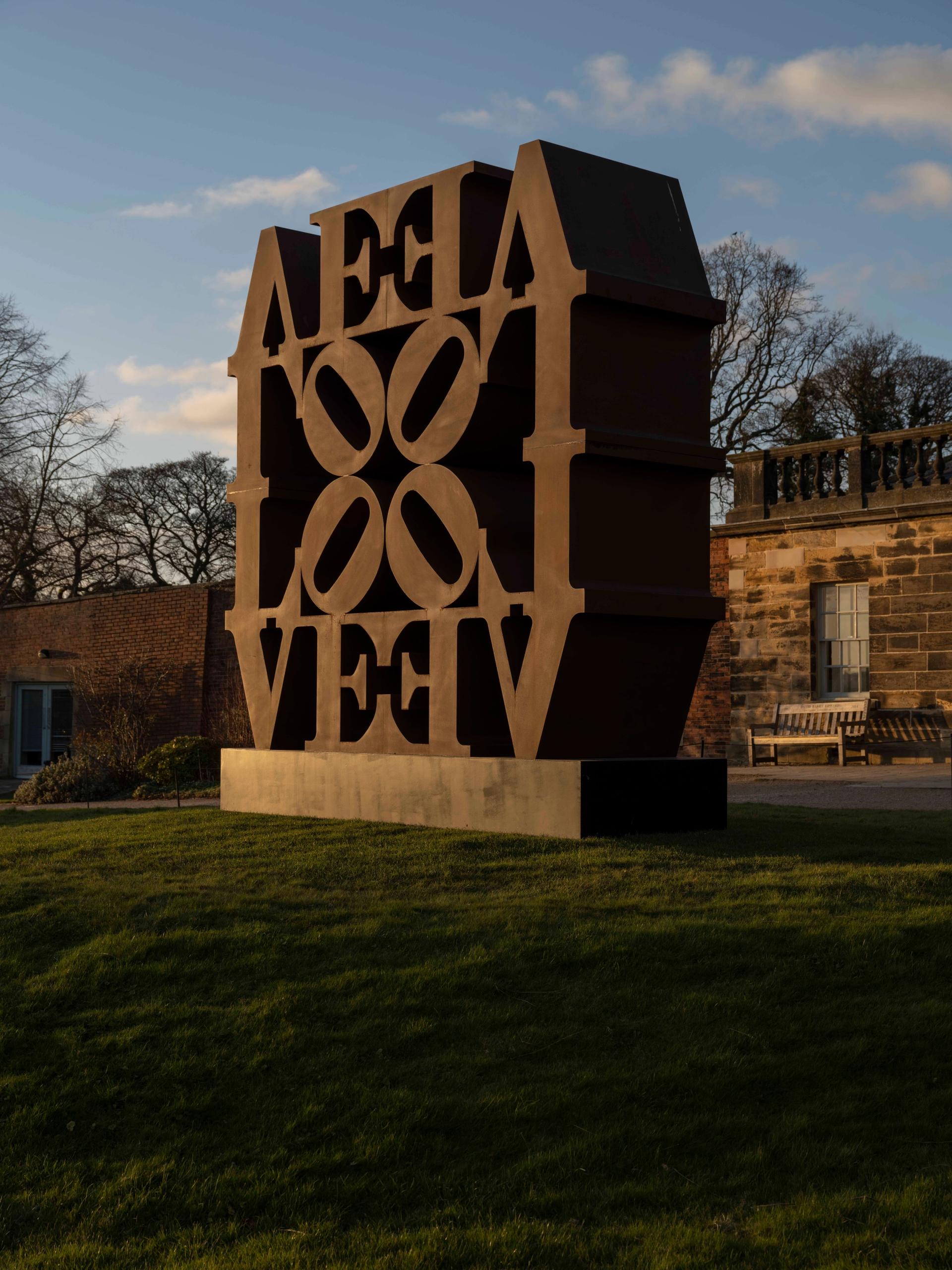Yorkshire | Robert Indiana’s first major UK exhibition opens with a timely pacifist messageby Anny Shaw |  |
LOVE in the time of war: Robert Indiana’s first major UK exhibition opens with a pacifist message more timely than ever
Yorkshire Sculpture Park show examines the latent meanings within some of the artist’s lesser-known sculptures
Robert Indiana, AMOR (Red Yellow), (1998-2006), installation view at Yorkshire Sculpture Park, 2022.Photo: © Jonty Wilde, courtesy of Yorkshire Sculpture Park. Artwork: © 2022 Morgan Art Foundation Ltd./ Artists Rights Society (ARS), New York/DACS, London
Right in the middle of Yorkshire Sculpture Park, visible from the brow of the next hill, stand four three and-a-half-metre tall letters: L-O-V-E, rendered in shocking red, green and blue. The words are the work of the late American artist Robert Indiana, whose first major exhibition in the UK opens at the Yorkshire institution this week.
Everyone knows Indiana for Love. Since he first sent it out into the world in 1964 as Christmas cards to his friends it has been endlessly reproduced on everything from tea towels to key rings, mugs and number plates (a later version was printed without copyright by the Museum of Modern Art in New York). “Love”, Indiana told this writer in 2012, in a rare interview at his home on Vinalhaven off the coast of Maine, “cinched my whole career, it put me on the map. But it also caused me grief and unhappiness, rip-offs and endless unpleasantness”.
Robert Indiana's USA 666 (1964-66); The Calumet (1961); Black and White LOVE, (1969); Yield Brother (1963); installation view at Yorkshire Sculpture Park, 2022.Photo: © Jonty Wilde, courtesy of Yorkshire Sculpture Park. Artwork: © 2022 Morgan Art Foundation Ltd./ Artists Rights Society(ARS), New York/DACS, London
More urgently, “make love not war” was the countercultural rallying cry at the time Indiana created his famous design at the height of the Vietnam War. Often considered part of a banal Pop art tradition, which seemed to favour superficial gloss over social engagement, Indiana’s Love was no less political than some of his most direct protests. Today, it is impossible not to see his words writ large without thinking of the escalating war in Ukraine.
Love is not the focus of the Yorkshire exhibition, however. Instead, it delves into the rich and complex body of sculptural work Indiana began in the early 1960s following a move to Coentis Slip, an artist enclave on the East River at the southern tip of Manhattan whose inhabitants included Ellsworth Kelly, Robert Rauschenberg, Jasper Johns and Agnes Martin.
At that time, many of the buildings on Coentis Slip were being demolished, leaving wooden beams and bits of metal lying in piles of rubble, which Indiana would scavenge and turn into wall-hangings and free-standing assemblages.
These rough-and-ready sculptures—some cast in bronze—often carried deeply personal as well as radically political meanings, many of them just as pertinent today: the threat of atomic annihilation, the fallacy of the American Dream, the treatment of Indigenous peoples, the denial of basic civil rights for Black people and the struggle of LGBTQ+ communities among them.
Working in a pre-Stonewall era, Indiana considered his own sexuality a private matter. Instead, he would create works with varying degrees of code embedded in them. Indiana’s herms, named after the stone torsos the ancient Greeks would place by the side of the road to denote a boundary, and which often bore male genitalia, are equally phallic.
One, titled Mars (1990; cast 2016), refers both to Mars, the god of war, and to the painter Marsden Hartley, another artist who would refer to his sexuality in his canvases. Another, Ahab (1960-62), represents a central character in Herman Melville's novel Moby-Dick. “With Moby-Dick there are very strong connotations of male sexual love on that whaling ship. That association of male same-sex relationships with seafaring would have been a very obvious code in the 1950s and 60s,” says Clare Lilley, the director of Yorkshire Sculpture Park.
Robert Indiana's LOVE WALL, (1966-2006), installation view at Yorkshire Sculpture Park, 2022.Photo: © Jonty Wilde, courtesy of Yorkshire Sculpture Park. Artwork: © 2022 Morgan Art Foundation Ltd./ Artists Rights Society (ARS), New York/DACS, London
While Indiana would print the title of his herms on them, words—and more specifically poetry—was a constant source of inspiration for the artist, who looked to the gay poet William Carlos Williams and the concrete poet Gertrude Stein, among others. Lilley believes his hard-edged sculptures (Love, Amor, etc) “are themselves a form of concrete poem”. Meanwhile, an early poem by Indiana, Wherefore the Punctuation of the Heart (1958), included in the YSP exhibition, reveals the artist’s sculptural shaping of those four letters: LOVE.
A significant number of the works featured in the exhibition have come from the Morgan Art Foundation, a private company based in Switzerland which has fabricated Indiana’s sculptures since 1987. However, this relationship has not been without its troubles. The Morgan is one of a number of parties to have been embroiled in legal battles over the creative legacy and rights to Indiana’s works since the artist died in 2018.
The majority of those disputes have recently been settled, though just last week, the New York-based art publisher Michael McKenzie filed a fresh complaint against the Artists Rights Society (ARS) in New York, positing that the organisation has wrongly claimed that it holds the copyright to Love. According to legal papers, ARS has been “charging many hundreds of licensees many hundreds of thousands of dollars for use of their falsely claimed copyright and collecting millions of dollars paid by the licensees to use the supposed ‘LOVE’ copyright”. ARS did not respond to request for comment.
Of course, for Indiana, Love was not a straightforward proposition, it also had more ambivalent meanings. As he put it: “Love is a dangerous commodity—fraught with peril.” In today’s climate, this rings truer than ever.




No comments:
Post a Comment